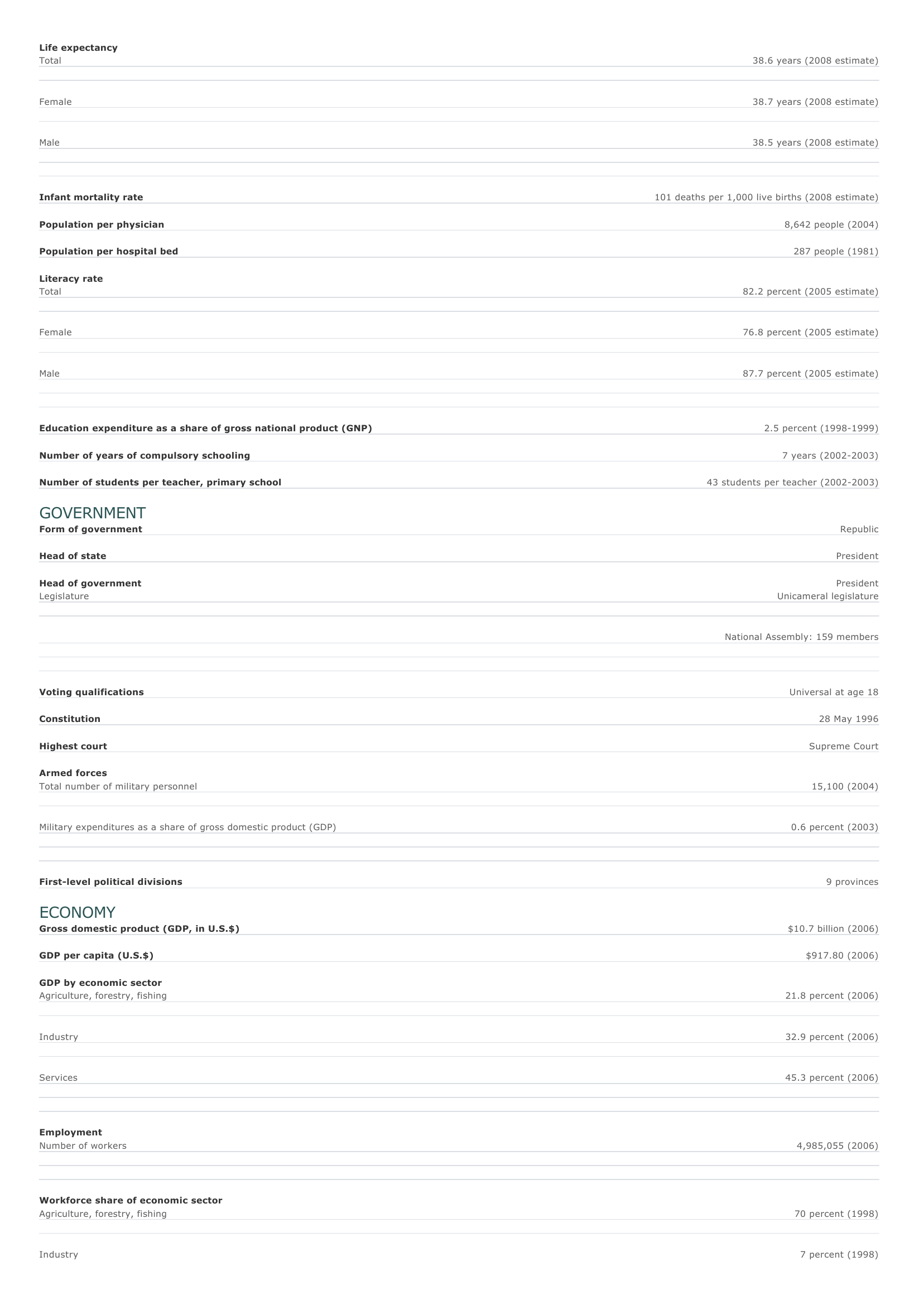Zambia Facts and Figures. BASIC FACTS Official name Capital Area Republic of Zambia Lusaka 752,614 sq km 290,586 sq mi PEOPLE Population 11,669,534 (2008 estimate) Population growth Population growth rate 1.65 percent (2008 estimate) Projected population in 2025 14,829,985 (2025 estimate) Projected population in 2050 18,435,053 (2050 estimate) Population density 16 persons per sq km (2008 estimate) 41 persons per sq mi (2008 estimate) Urban/rural distribution Share urban 35 percent (2003 estimate) Share rural 65 percent (2003 estimate) Largest cities, with population Lusaka 1,394,000 (2003 estimate) Kitwe 376,124 (2000) Ndola 374,757 (2000) Chingola 241,612 (2000) Kabwe 233,197 (1999 estimate) Ethnic groups Bemba, Nyanja, Tonga, many others Languages English (official), Bemba, Luapula, Nyanja, Tonga, Lozi, Kikaonde, Lunda, Luvale NOTE: There are about 70 indigenous languages. Religious affiliations Roman Catholic 33 percent Protestant 30 percent Independent Christian 17 percent Ethnoreligionist or indigenous beliefs 14 percent Baha'i 2 percent O ther 4 percent HEALTH AND EDUCATION Life expectancy Total 38.6 years (2008 estimate) Female 38.7 years (2008 estimate) Male 38.5 years (2008 estimate) Infant mortality rate Population per physician Population per hospital bed 101 deaths per 1,000 live births (2008 estimate) 8,642 people (2004) 287 people (1981) Literacy rate Total 82.2 percent (2005 estimate) Female 76.8 percent (2005 estimate) Male 87.7 percent (2005 estimate) Education expenditure as a share of gross national product (GNP) Number of years of compulsory schooling Number of students per teacher, primary school 2.5 percent (1998-1999) 7 years (2002-2003) 43 students per teacher (2002-2003) GOVERNMENT Form of government Head of state Head of government Legislature Republic President President Unicameral legislature National Assembly: 159 members Voting qualifications Constitution Universal at age 18 28 May 1996 Highest court Supreme Court Armed forces Total number of military personnel 15,100 (2004) Military expenditures as a share of gross domestic product (GDP) First-level political divisions 0.6 percent (2003) 9 provinces ECONOMY Gross domestic product (GDP, in U.S.$) GDP per capita (U.S.$) $10.7 billion (2006) $917.80 (2006) GDP by economic sector Agriculture, forestry, fishing 21.8 percent (2006) I ndustry 32.9 percent (2006) Services 45.3 percent (2006) Employment Number of workers 4,985,055 (2006) Workforce share of economic sector Agriculture, forestry, fishing 70 percent (1998) I ndustry 7 percent (1998) Services 23 percent (1998) Unemployment rate 12 percent (1998) National budget (U.S.$) Total revenue $1,898 million (2006) Total expenditure $2,143 million (2006) Monetary unit 1 Zambian kwacha (K), consisting of 100 ngwee Major trade partners for exports South Africa, Malawi, Thailand, Saint Pierre and Miquelon, and Japan Major trade partners for imports South Africa, China, United Kingdom, Japan, and India ENERGY, COMMUNICATIONS, AND TRANSPORTATION Electricity production Electricity from thermal sources Electricity from hydroelectric sources 0.56 percent (2003 estimate) 99.44 percent (2003 estimate) Electricity from nuclear sources 0 percent (2003 estimate) Electricity from geothermal, solar, and wind sources 0 percent (2003 estimate) Number of radios per 1,000 people 149 (1999 estimate) Number of telephones per 1,000 people 8 (2005) Number of televisions per 1,000 people 142 (2000 estimate) Number of Internet hosts per 10,000 people 1.7 (2003) Daily newspaper circulation per 1,000 people 14 (1996) Number of motor vehicles per 1,000 people 26 (1997) Paved road as a share of total roads 22 percent (2001) SOURCES Basic Facts and People sections Area data are from the statistical bureaus of individual countries. Population, population growth rate, and population projections are from the United States Census Bureau, International Programs Center, International Data Base (IDB) (www.census.gov). Urban and rural population data are from the Food and Agriculture Organization (FAO) of the United Nations (UN), FAOSTAT database (www.fao.org). Largest cities population data and political divisions data are from the statistical bureaus of individual countries. Ethnic divisions and religion data are largely from the latest Central Intelligence Agency (CIA) World Factbook and from various country censuses and reports. Language data are largely from the Ethnologue, Languages of the World, Summer Institute of Linguistics International (www.sil.org). Health and Education section Life expectancy and infant mortality data are from the United States Census Bureau, International Programs Center, International database (IDB) (www.census.gov). Population per physician and population per hospital bed data are from the World Health Organization (WHO) (www.who.int). Education data are from the United Nations Educational, Scientific and Cultural Organization (UNESCO) database (www.unesco.org). Government section Government, independence, legislature, constitution, highest court, and voting qualifications data are largely from various government Web sites, the latest Europa World Yearbook, and the latest Central Intelligence Agency (CIA) World Factbook. The armed forces data is from Military Balance. Economy section Gross domestic product (GDP), GDP per capita, GDP by economic sectors, employment, and national budget data are from the World Bank database (www.worldbank.org). Monetary unit, agriculture, mining, manufacturing, exports, imports, and major trade partner information is from the statistical bureaus of individual countries, latest Europa World Yearbook, and various United Nations and International Monetary Fund (IMF) publications. Energy, Communication, and Transportation section Electricity information is from the Energy Information Administration (EIA) database (www.eia.doe.gov). Radio, telephone, television, and newspaper information is from the United Nations Educational, Scientific and Cultural Organization (UNESCO) database (www.unesco.org). Internet hosts, motor vehicles, and road data are from the World Bank database (www.worldbank.org). Note Figures may not total 100 percent due to rounding. Microsoft ® Encarta ® 2009. © 1993-2008 Microsoft Corporation. All rights reserved.











